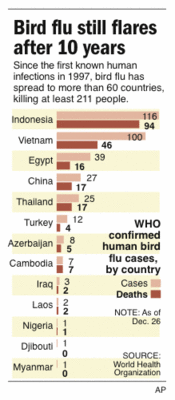
|
| ©AP |
Bird flu has since spread to more than 60 countries in Asia, Africa, Europe and the Middle East, killing at least 211 people along with hundreds of millions of birds. Pakistan and Myanmar reported their first human infections earlier this month. Indonesia, the world's hardest-hit country, reported its 94th death Wednesday while Vietnam and Egypt also logged a death each the same day.
In stricken places like Vietnam, people have learned to live with the disease. Children are taught about bird flu in elementary school, and the nation's poultry is vaccinated twice a year.
But much about the H5N1 virus remains unknown. Experts are still puzzled by its ability to spread and kill. They also do not understand why it infects only a few people, and fear it could morph into a new form that spreads easily among humans, potentially sparking a pandemic that kills millions and cripples national economies.
"It doesn't cease to amaze me that every week or every day we learn something new about this virus," said Juan Lubroth, an animal health expert at the U.N. Food and Agriculture Organization in Rome. "From the very beginning we've been saying that no poultry producing country is safe from this disease."
Migration mystery
The World Health Organization is currently working to determine whether limited human-to-human transmission could have occurred in Pakistan where up to nine suspect cases were detected, including several relatives. The last infection was reported Dec. 6, and experts say there appears to be no threat of further spread.
A number of other countries have recently detected poultry outbreaks during the winter months when the virus typically flares. The reason why remains unclear, though some experts suspect a pattern that may be similar to seasonal human influenza, which surfaces every year as temperatures drop.
Another mystery is how the virus spreads internationally. How much of a role do migrating wild birds play in transmitting it compared to the trade and movement of poultry, which often crosses borders illegally?
"There are so many questions that are unanswered, and so many things have to come together to cause a pandemic, that nobody can predict it," said Dr. David Heymann, the WHO's top flu official in Geneva. "We don't know all the risk factors."
Most human cases have been linked to contact with infected birds. Scientists believe human-to-human transmission has occurred a few times, but only among relatives in close contact.
Changing daily habits
In Vietnam, where the virus is entrenched in poultry and 47 people have died, bird flu is no longer a major worry for most who now understand that eating properly cooked eggs and poultry is safe.
Many have changed their shopping and cooking habits to limit the risk, while farmers are more likely to report dead birds because they receive compensation for slaughtering their flocks when sporadic flare-ups occur.
"In small markets around the corner, you see no live chickens," said To Long Thanh, vice director of Vietnam's National Center for Veterinary Diagnosis. "They're already slaughtered and put in a bag. People use gloves to cut it and cook it."
In the winter, warnings are issued to every city and province mandating that vaccinations be finished by a certain date, Thanh said. Animal health experts follow up to make sure no farms have been missed.
"We have a program until 2010 because we cannot predict when it will stop," he said.
WHO is watching other strains of bird flu, including H7 and H9, that are circulating among poultry and have also infected humans.
Still, H5N1 continues to be the virus experts worry most about, because it has spread so far, so fast. More than 60 percent of people infected by it have died.
"We just don't understand it, and what you don't understand is what's dangerous," Heymann said. "So, you have to be dramatic and take the most severe precautions."



Reader Comments
to our Newsletter